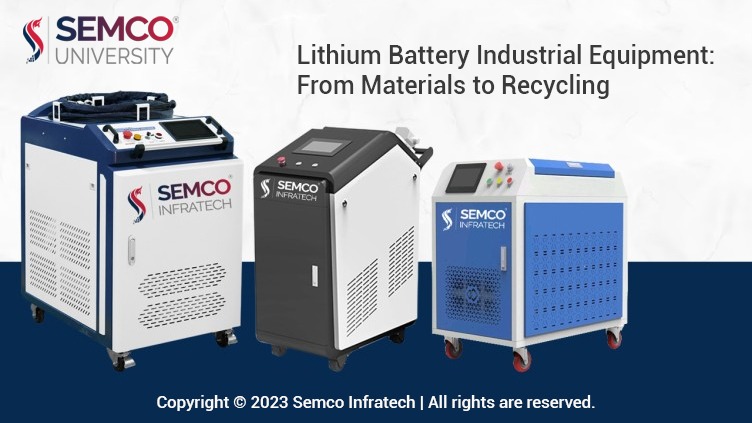Introduction
The modern world is increasingly reliant on lithium-ion batteries, powering everything from
smartphones to electric vehicles. Behind the scenes, a range of sophisticated industrial equipment
and technologies play a pivotal role in the mass production, assembly, testing, and recycling of these
essential energy storage devices. In this article, we will delve into the intricate world of lithium-ion
battery industrial equipment and explore the specific tools and technologies used at each stage of
the battery manufacturing process.
Lithium Battery Material Preparation Equipment
The journey of a lithium-ion battery begins with the preparation of its materials. This phase involves
a series of crucial steps facilitated by specialized equipment:
Mixing Equipment: Mixing equipment is employed to blend positive materials, negative materials,
electrolytes, and other raw materials uniformly. This process ensures that the battery components
are evenly distributed and includes mixers and ball mills.

Grinding Equipment: Grinding equipment is used to refine raw material powders, reducing them to
smaller particles. This enhances the specific surface area and reactivity of the electrode materials.
Common grinding equipment includes ball mills and grinders.
Coating Equipment: Coating equipment is responsible for applying a consistent layer of material
slurry onto copper foil or aluminum foil, creating positive and negative electrode sheets.
Equipment in this category includes coating machines and homogenizing machines.
Drying Equipment: After the material slurry is applied to the electrode sheet, drying equipment is
used to remove solvents and dry the coated material. This category includes ovens and vacuum
drying ovens.
Lithium Battery Assembly Equipment
Once the materials are prepared, the next step involves assembling the battery components:
Battery Shell Assembly Equipment: This equipment is used to assemble positive electrodes, negative
electrodes, separators, and other components within the battery casing, forming a battery cell.
Common machines in this category are stacking machines and winding machines.
Battery Monomer Assembly Equipment: This equipment is responsible for assembling multiple
battery cells into larger modules or battery packs. It includes module packaging machines and
assembly lines.

Battery Packaging Equipment: Battery packaging equipment is essential for sealing the battery to
ensure safety and airtightness. This category comprises sealing machines and hot presses.
Lithium Battery Test Equipment
Quality control and performance assessment are critical aspects of battery manufacturing. Lithium
battery test equipment is used for various assessments:
Capacity Test Equipment: This equipment measures the capacity characteristics of the battery, often
utilizing discharge test machines and charge-discharge test systems.
Charge and Discharge Performance Test Equipment: These tools evaluate the charging and
discharging performance of batteries and including charge-discharge test systems and cycle test
machines.
Aging Test Equipment: Aging test equipment simulates battery usage conditions, subjecting batteries
to temperature fluctuations and stress testing. This category encompasses temperature cycle boxes
and high-low temperature aging chambers.
Lithium Battery Production Line Automation Equipment
Automation is increasingly vital in battery production for efficiency and consistency. Automation
equipment includes:
Robots/Robotics: Robots are employed for assembly, transfer, and quality control tasks along the
production line.
Automatic Conveying Systems: These systems automatically transport products between different
processes, enhancing production efficiency and line continuity.
Lithium Battery Recycling Equipment
The sustainability of lithium-ion batteries hinges on recycling. To recover valuable materials and
reduce environmental impact, recycling equipment is used:
Battery Disassembly Equipment: This equipment disassembles used lithium-ion batteries, separating
battery housings, positive and negative materials, and other components. It includes disassembly
machines and sorting equipment.

Battery Material Recovery Equipment: This equipment processes and reclaims recycled battery
materials, such as grinding and screening for positive materials.
Conclusion
The production of lithium-ion batteries is a sophisticated process that relies heavily on specialized
industrial equipment and technologies. From material preparation to recycling, each stage demands
precision and efficiency to create reliable and sustainable energy storage solutions for our modern
world. As technology continues to advance, these industrial tools will play an increasingly critical role
in shaping the future of energy storage.
About Semco – Semco University is an educational website that is catering to the needs of students and researchers. Offering information on Lithium-ion batteries. The resources and content are compiled from various sources including manufacturers, test labs, crowdsourcing, etc. Our motto is to provide a viable resource for companies, students, and enthusiasts interested in participating in the Li-ion Battery industry. Our initiative is to make people aware of the benefits, and opportunities of the revolutionary Lithium Batteries for multiple applications.
For More Updates Follow Us
WhatsApp – Facebook – Instagram – Twitter – LinkedIn – YouTube

